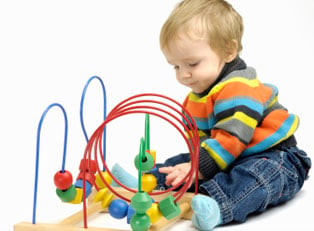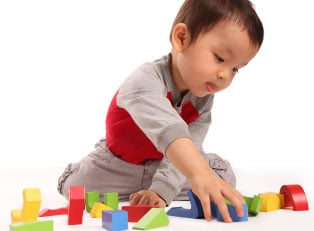Between 3-6 months, babies are less interested in eating and sleeping all the time and start becoming much more interested in their environment. Your baby is constantly learning about the world and people around him. Physical growth and developments will also become more apparent. Some of the reflexes present at birth (like startling) are starting to fade away, and new abilities are becoming evident. Here’s a look at what to expect from your baby’s development at the 3-6 month mark.
Social Skills and Communication
Your baby loves to see your face and hear your voice. Despite her minimal comprehension, reading and talking to your baby encourages verbal and nonverbal communication and sets the stage for social development. Not only can she recognize your face, but she may smile or kick and wave to show how excited she is to see you. Babies at this age are learning to mimic facial expressions and start telling one person’s face from another. She probably enjoys smiling at herself in the mirror and watching at other babies.
Babies at this age are also starting to understand how communication works. Expect a lot of babbling, smiling, laughing, and even recognizing her name. Your baby is also learning to express emotions like excitement or look for comfort when she’s sad.
Gross and Fine Motor Skills
The difference between a three-month-old and a six-month-old is quite marked. By three months, he should have good control of his neck and be able to wiggle around voluntarily. By six months, he should be able to roll over, reach for toys, support his own weight with assistance, and learning to sit unsupported. He may even start trying to crawl! Encourage rolling over and crawling by placing favorite toys just out of reach during tummy time.
Sleeping
By this time, your little one should be having fewer midnight feedings and starting to sleep for longer stretches -- you might even get eight hours of uninterrupted sleep. As her body matures and grows, she can accommodate more milk, which means greater quantity and less frequency. Additionally, nap time will shrink to a few times a day for more extended periods of time. Sleeping on her back is still safest, but if she starts flipping over in her sleep, don’t panic -- just roll her back over.
The Senses
Infant senses are really starting to develop now, too. His sight is much better than it was at birth, and he will begin to enjoy brightly colored toys and contrasting patterns (like zebra stripes). Music is a great tool at this age, and his parents’ voices are exciting to hear. Preferred toys include noisy rattles and his own hands and feet.
When to Worry
Not all babies develop the same, but it’s important to understand the warning signs. If your baby isn’t reaching for toys, responding to sounds, tracking people or moving objects with her eyes, smiling, or have any interest in cuddling, talk to your pediatrician about your concerns.



